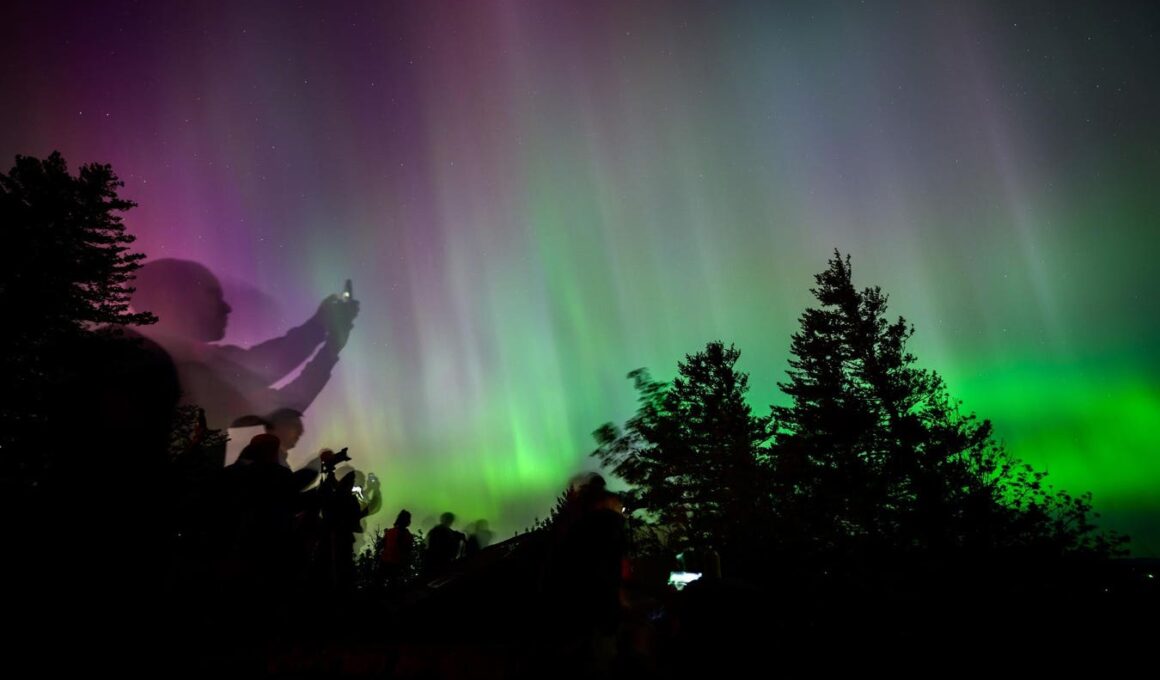Topline
A select group of U.S. states have a shot at seeing the Northern Lights this weekend as geomagnetic activity ramps up Saturday—one day before a Perseid meteor shower is forecasted to peak, providing some observers with the opportunity to potentially see multiple meteors in one sitting.
The lights are ideally viewed between 10 p.m. and 2 a.m. (Photo by Mathieu Lewis-Rolland/Getty … [+]
Key Facts
The aurora borealis forecast for Saturday night has a Kp index of five, meaning the lights are expected to become brighter and provide a visible viewing experience for those “in the right place,” according to the National Oceanic and Atmospheric Administration.
NOAA stated in a weekend space weather forecast that solar material which erupted from some overactive sunspots are expected to be visible early Saturday morning and Sunday night.
A geomagnetic storm watch is in place until Sunday and noted the aurora could be visible over northern states.
Observers could get a glimpse at the northern lights alongside the Perseid meteor shower—a highly active meteor event expected to peak between Sunday night and Monday morning.
Get Forbes Breaking News Text Alerts: We’re launching text message alerts so you’ll always know the biggest stories shaping the day’s headlines. Text “Alerts” to (201) 335-0739 or sign up here.
Where Will The Lights Be Visible Tonight?
The aurora forecast for Saturday and Sunday night gives the northern parts of states such as Washington, Idaho, Montana, North Dakota, Minnesota and Maine a low chance to see the lights (see the chart below).
Saturday’s viewing regions.
How Do You See The Lights?
Lights are usually most active between 10 p.m. and 2 a.m. and can be better seen in areas with little to no cloud cover and minimal light pollution.
How Do You Photograph The Lights?
Smartphones should be turned on to night mode to change exposure time, which could show the lights’ movement depending on how long the time is set for, according to Visit Iceland.
Tangent
Anchorage, Alaska, has a high chance of seeing the lights on both nights, according to NOAA, which notes an aurora does not need to be directly overhead for observers and can be seen from as far away as 621 miles if the lights are bright and conditions are ideal.
Key Background
2024 has marked a strong year for solar activity and coincided with the sun’s 11-year solar cycle approaching a peak forecasted for late this year and early 2026. Projections from NOAA anticipate a peak including 115 sunspots—where geomagnetic storms come from before they generate auroras. Meanwhile, the Perseid meteor shower’s peak is expected to generate more than 50 meteors per hour. Astronomers warn the meteors can be faint to the naked eye and have advised observers to put their phones away and avoid light pollution, as it can take the eyes up to 30 minutes to fully acclimate to night visibility.
Further Reading
Perseid Meteor Shower: Why Astronomers Recommend Putting Your Phone Away For This Weekend’s Show (Forbes)
Elon Musk’s Twitter takeover, the Reddit blackout protest and debunked viral rumors. Prior to joining Forbes, Antonio was a reporter with the San Fernando Valley Business Journal and Los Angeles Business Journal covering the local finance and biotech sectors. He graduated from California State University San Marcos in 2020 and completed a master’s degree in journalism at the University of Southern California the following year. Follow Pequeño for continued coverage on Elon Musk, X and ongoing developments at various social media companies. Tips: apequeno@forbes.com.
“>







